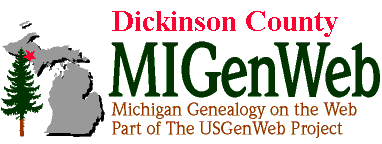Metropolitan
|
This town was named after the Metropolitan Mine which had been opened in the 1870's. In its early days, the area known today as Metropolitan West was a booming sawmill town known locally as "Milltown," while today's Felch was then known as East Metropolitan. The large and sprawling sawmill was located on the Sturgeon River, south of Milltown. (I emphasize the word "locally" since all the residents are listed as living in Metropolitan during the enumeration of the censuses.) For the sake of simplicity, I will treat this region as one area. The village of Metropolitan was platted in 1882 with the request signed by S.P. Burt, president and secretary of The Metropolitan Iron and Land Company. It was a typical company town with a company store, rows and rows of company houses all built alike and renting from three to five dollars a month, board sidewalks and a water spring or well for each block of houses. By 1893 the entire area known as Metropolitan and Felch Mountain was booming. There were more hotels and each one had a sample room and saloon. John Atkinson was postmaster; M.J. Finnegan managed the company store. The Ford River Lumber Company had offices there; Miss C. Fry was music teacher; Ed Fry was a barber; J.B. Fry managed the Metropolitan Hotel; Dr. J.B. Gaston was active in politics; D.M. Layton was school teacher; Reverend Lawrence Long served the Catholic Church; Angus McDonald had the Traveler's Home Hotel and Saloon; Andrew Rian sold boots and shoes; and there was a Scandinavian House with A. Willman as proprietor. In 1900 the company store was next to the depot and the town's single saloon. A large hotel was operated by Nick Candles and his wife. The Candles' daughter, Lillian, was postmistress during the entire time Milltown existed and then she moved to Foster City. Sara Reath of Vulcan taught in the village's one-room schoolhouse in 1900. Near the school was the multi-tasked Town Hall. In connection with it was a small library run by librarian, Mary Fenlon. She kept the library open one evening a week. It was used for night classes to teach English to the immigrants at the turn of the century. In addition, the young people held dances there every Saturday night, accompanied by the music of accordions. In 1903 the Town Hall was used as a second school. The teacher was Alfred Lawrence, who had come up from Lower Michigan. By 1905 the Metropolitan Lumber Company had completely moved its operations from the area and had offered jobs to men who wanted to move to California to work in a company mill there. In 1913 there were still a number of families living in Milltown, but most of the houses had been moved out. Company officials left first, followed by families moving on to other boom towns where mills were opening. The Pittsburgh Lumber Company, J. Muller Company, and some other small companies came in to Milltown and maintained operations and the majority of the Swedish speaking people from Finland stayed on and gradually began buying land for farming. Some of them bought company houses to move to the own land. A large percent of Milltown homes were sold in prices ranged from $100-$250 and moved to other areas. John Ovist and Gustav Oberg operated the company store for some years after the mill left and Alfred Anderson took over when Ovist and Oberg left to operate a store in Felch. Alfred Anderson was Metropolitan's Postmaster in 1913. Mr. and Mrs. Erik Skog came from Sweden to the U.S. in 1883. They were the first settlers to begin farming in the Milltown area. They were still in Metropolitan in 1920. Mr. Skog had acquired considerable land which he sold to many young families who began farming.
|
